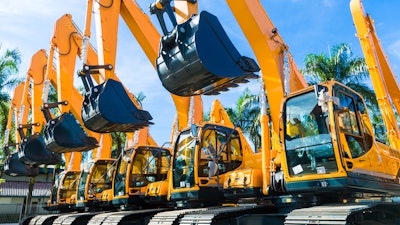
The first quarter of 2021 has proved to be a positive one for many in the heavy equipment industries. OEMs and component manufacturers have begun releasing their first quarter financial results, many of which have shown gains compared to the first quarter of 2020.
Volvo Group, for instance, says the first quarter (Q1) saw high customer activity and demand for new products and services. As such, the company reports a 3% increase in net sales compared to the same period in 2020.
Since the second half of 2020, many industries have begun to see improvements as economies have recovered. While there is still much uncertainty surrounding the COVID-19 pandemic, work has picked up in many industries which has brought about renewed equipment demand.
However, strained supply chains could present challenges for manufacturers in at least the first half of the year. Volvo Group has already reported the current global semiconductor shortage will impact its truck production, and could affect other parts of its business as well.
READ MORE: Biden Executive Order Looks to Solve Semiconductor Chip Supply Shortage for Manufacturers
Material costs have also increased, and there continue to be trade issues which are negatively impacting supply and costs. There was some reprieve in March when President Joe Biden and European Commission President Ursula von der Leyen announced a temporary suspension of tariffs between the U.S. and Europe.
In general though, and as companies' first quarter results indicate, the heavy equipment and related markets are recovering from 2020.
Off-road equipment markets recovering
Manufacturers in the heavy-duty off-road equipment markets—such as construction, mining and agriculture—continue to see recovery which began in the last half of 2020. As customers began to take on more projects and feel more confident about the economy, equipment demand increased.
"The good sales volumes, not least in the service business, and our own measures to keep costs down contributed to the adjusted operating income improving to SEK 11.8 billion (7.1). The adjusted operating margin increased to a historically high 12.6% (7.8),” says Martin Lundstedt, President and CEO, Volvo Group, in the company's press release announcing its first quarter 2021 results.
In its press release the company notes net sales increased 13% on an adjusted currency basis, and that the shortage of semiconductors is impacting production.
Volvo Construction Equipment (Volvo CE) reports Q1 2021 sales increased 23% due to a high level of infrastructure and construction activity. It says in its press release announcing the company's first quarter results that it experienced a sharp increase in orders—up 73%—compared to the previous year. 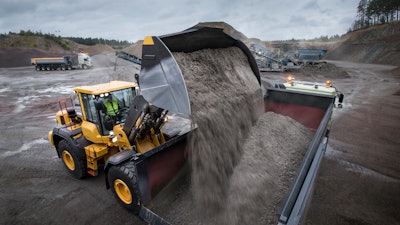 Volvo CE reports strong infrastructure and construction activity lead to an increase in equipment sales in the first quarter.Volvo Construction Equipment
Volvo CE reports strong infrastructure and construction activity lead to an increase in equipment sales in the first quarter.Volvo Construction Equipment
The company says demand in China was particularly strong because of government infrastructure investments. Sales increased in all global markets and segments, though, and low inventory at dealers also helped with order increases during the quarter. Volvo CE says demand for large- and medium-sized machinery was stronger during Q1 than for compact machines.
Volvo CE notes it was a slow start for the European market in the first quarter because of COVID-19 restrictions in many countries, but there has been increased momentum since the start of the year. Net order intake in Europe increased 87% due to stronger demand in the second half of the quarter, although the company notes Europe's total market development has declined 9%. Additional market improvements included:
- China's market development is up 142%
- Asia (not including China) saw a 16% improvement
- South America was up 41% from last year
- North America is up 7% due to positive customer sentiment from expected government infrastructure investments.
READ MORE: Biden Infrastructure Plan will Benefit Equipment Manufacturers
Construction equipment demand increased in the UK leading to a 30% rise in sales during Q1 2021, reports the Construction Equipment Association (CEA). Per the association's press release announcing first quarter figures, retail sales for construction and earthmoving equipment in March were almost double that of the same month last year. This lead to an increase in Q1 sales, with total units sold reaching over 8,000 units.
CEA notes in its press release sales were also 2.9% above 2019 levels, further indicating the increased momentum of the construction industry. It says there is some concern equipment sales could be hindered by supply chain constraints, but in general there is growing confidence sales will see a strong recovery in 2021.
Excavators are the main driver for sales in the industry, CEA says in its press release. Mini/Midi excavators (up to 10 tonnes) and other crawler excavators had the strongest growth during the quarter, while road rollers and telehandlers also showed strong recovery.
CEA says sales in the South East were the strongest (+39%), while Wales saw the weakest sales in the first quarter, which were still 2% below last years' levels. It also notes construction sales in the Republic of Ireland had a more modest increase in March which lead to a 12% sales increase for Q1 2021.
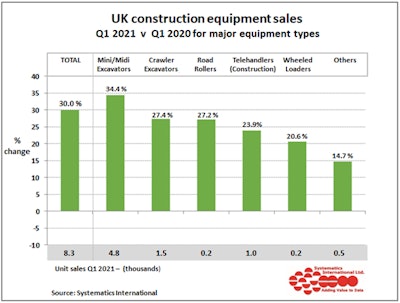 Construction Equipment Association (CEA)
Construction Equipment Association (CEA)
The Association of Equipment Manufacturers' (AEM) economic partner Oxford Economics reports the U.S. construction machinery market contracted 11.5% in 2020. Double-digit growth is expected for 2021, with a rise of 15.2% currently anticipated. The proposed American Rescue Plan and other government stimulus will aid recovery of the construction equipment market in 2021 and 2022.
Agricultural equipment demand faired better in 2020, though production shrank 5.8% due to the pandemic says Oxford Economics. Strong consumer and export demand in the second half of the year helped the market recover, and this momentum is expected to continue into 2021 and grow 15.8%.  Demand for agricultural equipment is expected to remain strong into 2022.©Yakov – stock.adobe.com
Demand for agricultural equipment is expected to remain strong into 2022.©Yakov – stock.adobe.com
AEM's most recent U.S. and Canada agricultural equipment market reports shows the industry finished the first quarter of 2021 on a strong foot. Per AEM, U.S. total farm tractor sales rose 84.1% in March while Canada saw positive sales in all tractor and combine segments.
According to Eric Raby, President & GM – Sales at CLAAS of America, demand for agricultural equipment is expected to be strong throughout 2021 and into 2022. Continued development of new technology will help drive customer demand he noted during a recent podcast interview with OEM Off-Highway; favorable commodity prices are also aiding the market.
Listen to our full podcast interview with CLAAS' Eric Raby to learn more about the agricultural equipment outlook.
The agricultural equipment market is recovering in other parts of the world, as well. FederUnacoma—the Italian agriculture industry association—reports registrations for farm machinery in Italy were up during the first quarter of 2021. Tractor registrations rose 57.7% while combine harvesters increased 180%. The association notes the increase in registrations is due in part to tax incentives from the government as well as demand for next-generation technology.
On-road truck demand remains at high levels
The heavy-duty truck market was not impacted as much in 2020 due in large part to the growing e-commerce industry and the continued need to deliver goods despite the pandemic. The industry ended the year on a high note and has thus far seen strong order activity in 2021.
In March 2021, Class 8 truck orders were above 40,000 units for the sixth month in a row. As reported by research firms FTR and ACT Research, demand for new trucks has remained high though supply chain constraints have posed challenging for many OEMs.
ACT Research's most recent State of the Industry: NA Classes 5-8 Report shows Class 8 orders booked during the past 6 months were surpassed only by the 6-month period ending October 2018. “Unlike that October 2018 period, where the seeds of the cycle’s fall had already been planted with tariffs and trade wars, the economy is carrying considerable pent-up industrial and consumer demand with stimulus program(s) adding fuel to the fire,” said Kenny Vieth, ACT Research’s President and Senior Analyst, in ACT Research's press release announcing its new report. “ACT’s current expectation for GDP growth in 2021 is 6.4%. Owing to the composition of economic activity, ACT’s GDP-based freight proxy anticipates freight volumes jumping by 12.6%.
 Class 8 truck demand remains at high levels in North America.©Vit – stock.adobe.com
Class 8 truck demand remains at high levels in North America.©Vit – stock.adobe.com
“That supplants 1984 as the best year on record, based on ACT’s freight composite methodology. While freight growth is expected to moderate, as consumer spending patterns begin to revert to more traditional levels of goods spending relative to services, both GDP and freight activity are expected to remain elevated.
“With the economy growing in all the right places, freight rates and carrier profits are pushing into record territory. In response, Class 8 orders the past two quarters have driven rapid backlog growth. Stating the obvious, perhaps, the supply chain’s ability to respond will be the key determinant of commercial vehicle production in 2021.”
READ MORE: 2021 is Looking Better for Most Global Commercial Vehicle Markets
Navistar International Corp. reported increased market share in each of its product segments during its fiscal 2021 first quarter. The company says in its press release announcing its Q1 2021 results that strong Class 6-8 truck orders during the quarter lead to an increase in production line-rates in both of its truck assembly plants. It plans to further increase production line-rates though Navistar says that is dependent upon the supply chain's ability to meet higher demand schedules.
"We expect the roll-out of COVID-19 vaccines and easing of state restrictions will continue to support strong economic growth and the need for new trucks," said Persio Lisboa, Chief Executive Officer, in the company's press release. "Our performance this quarter, along with the sustained execution of our Navistar 4.0 strategy and future opportunities with TRATON, positions Navistar to deliver increased value to our customers, dealers, partners and other stakeholders."
Daimler AG reports it has raised its outlook for the full year 2021 due to positive results it experienced during the first quarter. Global economic recovery lead to a sales increase of 13%. “Deliveries, revenues and profits increased significantly, particularly thanks to tailwinds in China, a strong product mix and favorable pricing, supported by industrial performance enhancements and cost control. After this promising start, we are very confident that we can keep up the pace to improve our margins on a sustainable basis and at the same time expand our electric vehicle line-up,” said Harald Wilhelm, Chief Financial Officer of Daimler AG, in the press release announcing Daimler's Q1 results.  Daimler's headquarters in Stuttgart, Germany.Daimler AG
Daimler's headquarters in Stuttgart, Germany.Daimler AG
Daimler Trucks & Buses achieved a 4% increase in sales to 101,300 vehicles. Daimler Trucks increased sales 6% during the quarter while the Daimler Bus segment experienced a 27% decrease.
The company says in its press release it expects a gradual normalization of economic conditions in the important markets, and that is assumes the world economy will recover from the pandemic-related weakness of 2020. Based on its market expectations, Daimler anticipates group sales and revenues will be significantly above the prior year level. The company does also note the global semiconductor shortage has affected deliveries in the first quarter and anticipates the shortage could impact second quarter sales. Based on these factors, it has adjusted its forecast returns for 2021 to be in the range of 6-7% for the Daimler Trucks & Buses division.
Despite continued uncertainty regarding the COVID-19 pandemic and current supply chain disruptions, in general the heavy-duty on- and off-highway vehicle and equipment markets are looking to be in a better position in 2021.






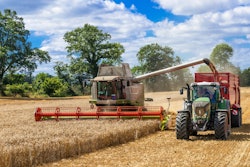

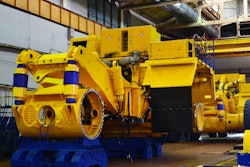






![Hcm Ax Landcros Press Release[32] jpg](https://img.oemoffhighway.com/mindful/acbm/workspaces/default/uploads/2025/11/hcmaxlandcros-press-release32jpg.mAEgsolr89.jpg?ar=16%3A9&auto=format%2Ccompress&fit=crop&h=135&q=70&w=240)




